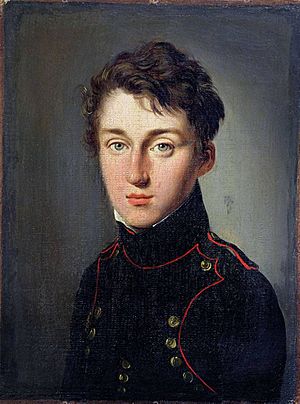Nicolas Léonard Sadi Carnot facts for kids
Quick facts for kids
Sadi Carnot
|
|
|---|---|

Nicolas Léonard Sadi Carnot in 1813 at age of 17 in the traditional uniform of a student of the École Polytechnique
|
|
| Born | 1 June 1796 Palais du Petit-Luxembourg, Paris, France
|
| Died | 24 August 1832 (aged 36) Paris, France
|
| Resting place | City of Paris Cemetery Ivry-sur-Seine |
| Nationality | France |
| Alma mater | École Polytechnique École Royale du Génie University of Paris Collège de France |
| Known for | Carnot cycle Carnot efficiency Carnot theorem Carnot heat engine |
| Scientific career | |
| Fields | Physicist |
| Institutions | French Army |
| Academic advisors | Siméon Denis Poisson André-Marie Ampère François Arago |
| Influenced | Émile Clapeyron Rudolf Clausius Lord Kelvin |
| Notes | |
|
He was the brother of Hippolyte Carnot, his father was the mathematician Lazare Carnot, and his nephews were Marie François Sadi Carnot and Marie Adolphe Carnot.
|
|
Nicolas Léonard Sadi Carnot (born 1 June 1796 – died 24 August 1832) was a French engineer and physicist. He is often called the "father of thermodynamics". Thermodynamics is the study of how heat, work, and energy are related.
Carnot wrote only one book, Reflections on the Motive Power of Fire (1824). In this book, he shared his ideas about how efficiently heat engines could work. His work laid the groundwork for the science of thermodynamics. Many years later, other scientists like Rudolf Clausius and Lord Kelvin used his ideas. They developed the second law of thermodynamics, which explains how energy changes. Carnot's ideas helped create modern technologies like the automobile and jet engine.
His father, Lazare Carnot, was a famous mathematician and military engineer. He was also a leader in the French Revolutionary Army.
Contents
Life of Sadi Carnot
Sadi Carnot was born in Paris, France, into a family known for science and politics. His father, Lazare Carnot, named him Sadi after a Persian poet. Sadi was the older brother of Hippolyte Carnot, who became a statesman. He was also the uncle of Marie François Sadi Carnot, who later became the President of France.
Early Education and Military Service
Sadi's father saw his potential and sent him to a good school in Paris. In 1811, at age 16, Sadi joined the École Polytechnique in Paris. This school trained engineers for the military. However, it also had many famous science teachers like André-Marie Ampère and François Arago. The school was well-known for its math lessons.
After graduating in 1814, Sadi studied military engineering. He then became an officer in the French Army. His father, Lazare, had worked for Napoleon. After Napoleon's final defeat in 1815, Lazare was forced to leave France. This made Sadi's position in the army difficult.
Sadi was sent to different places to inspect forts and write reports. He felt his ideas were not being used, and his career was not moving forward. In 1818, he took a break to prepare for another military exam.
Focus on Science
In 1819, Sadi moved to a new military department in Paris. He was still ready for military duty, but he spent most of his time on his own studies. He became friends with other scientists and attended lectures on physics and chemistry. He became very interested in steam engines. He wanted to understand why they couldn't be more efficient. This led him to write his famous book, Reflections on the Motive Power of Fire, published in 1824.
Carnot left the army in 1828. In 1832, he became very ill and died from cholera at age 36.
Carnot's Big Ideas: How Engines Work
When Carnot started his work, steam engines were very important for industry. But no one had really studied them scientifically. The first steam engine was invented in 1712. Later, James Watt made big improvements, making engines much more useful.
Engineers at the time tried to make engines better by using high-pressure steam. But a typical engine only turned about 3% of its fuel's energy into useful work. Carnot wanted to find out if engines could be made much more powerful. He also wondered if using different liquids or gases could make them better.
The Carnot Cycle
Carnot wrote his book to answer these questions. He was only 27 years old. The most important part of his book described an ideal, perfect engine. This engine helped him understand the basic rules for all heat engines.
Carnot imagined a perfect heat engine that had no friction or wasted heat. He showed that how efficient this ideal engine was depended only on the temperatures it worked between. The bigger the difference between the hot and cold temperatures, the more efficient the engine could be. No real engine can be more efficient than Carnot's ideal engine.
He also realized that heat moving between parts of an engine at different temperatures wastes energy. To get the best efficiency, this heat transfer must be avoided. Carnot also believed that the type of liquid or gas used in the engine did not change its maximum efficiency.
Impact of His Work
Carnot's book quickly went out of print and was hard to find for many years. Later, scientists like Lord Kelvin and Rudolf Clausius rediscovered his work. They used his ideas to develop the laws of thermodynamics.
Carnot's theories didn't immediately make steam engines better. But they explained why certain engine designs were more efficient. Later, his ideas helped engineers like Rudolf Diesel design new engines. The diesel engine, for example, uses a much higher hot temperature, making it more efficient, just as Carnot's theories suggested.
Works
- Reflections on the Motive Power of Fire (1824)
See also
 In Spanish: Nicolas Léonard Sadi Carnot para niños
In Spanish: Nicolas Léonard Sadi Carnot para niños

